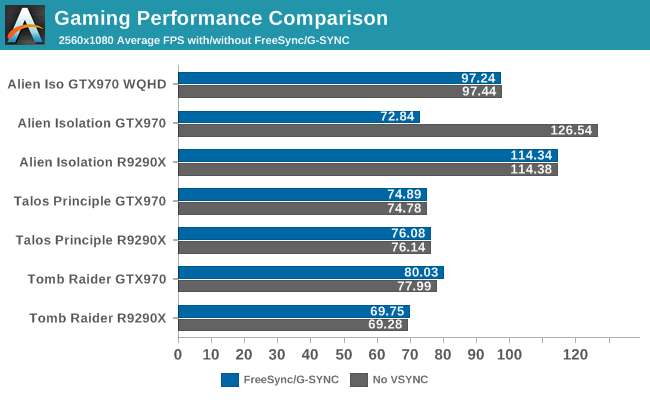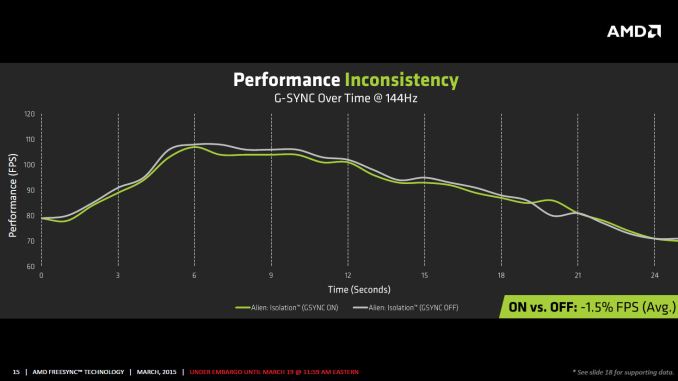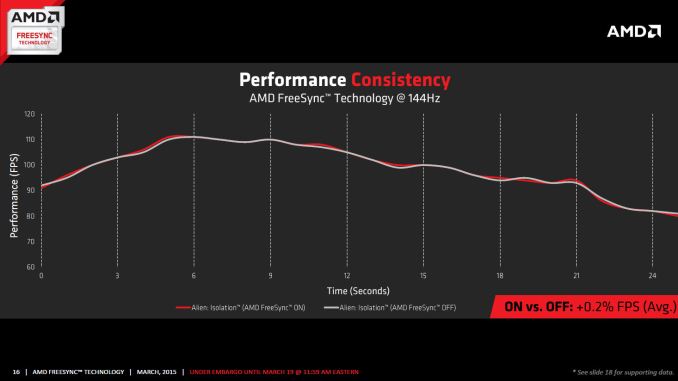The AMD FreeSync Review
by Jarred Walton on March 19, 2015 12:00 PM ESTFreeSync vs. G-SYNC Performance
One item that piqued our interest during AMD’s presentation was a claim that there’s a performance hit with G-SYNC but none with FreeSync. NVIDIA has said as much in the past, though they also noted at the time that they were "working on eliminating the polling entirely" so things may have changed, but even so the difference was generally quite small – less than 3%, or basically not something you would notice without capturing frame rates. AMD did some testing however and presented the following two slides:
It’s probably safe to say that AMD is splitting hairs when they show a 1.5% performance drop in one specific scenario compared to a 0.2% performance gain, but we wanted to see if we could corroborate their findings. Having tested plenty of games, we already know that most games – even those with built-in benchmarks that tend to be very consistent – will have minor differences between benchmark runs. So we picked three games with deterministic benchmarks and ran with and without G-SYNC/FreeSync three times. The games we selected are Alien Isolation, The Talos Principle, and Tomb Raider. Here are the average and minimum frame rates from three runs:


Except for a glitch with testing Alien Isolation using a custom resolution, our results basically don’t show much of a difference between enabling/disabling G-SYNC/FreeSync – and that’s what we want to see. While NVIDIA showed a performance drop with Alien Isolation using G-SYNC, we weren’t able to reproduce that in our testing; in fact, we even showed a measurable 2.5% performance increase with G-SYNC and Tomb Raider. But again let’s be clear: 2.5% is not something you’ll notice in practice. FreeSync meanwhile shows results that are well within the margin of error.
What about that custom resolution problem on G-SYNC? We used the ASUS ROG Swift with the GTX 970, and we thought it might be useful to run the same resolution as the LG 34UM67 (2560x1080). Unfortunately, that didn’t work so well with Alien Isolation – the frame rates plummeted with G-SYNC enabled for some reason. Tomb Raider had a similar issue at first, but when we created additional custom resolutions with multiple refresh rates (60/85/100/120/144 Hz) the problem went away; we couldn't ever get Alien Isolation to run well with G-SYNC using our custome resolution, however. We’ve notified NVIDIA of the glitch, but note that when we tested Alien Isolation at the native WQHD setting the performance was virtually identical so this only seems to affect performance with custom resolutions and it is also game specific.
For those interested in a more detailed graph of the frame rates of the three runs (six total per game and setting, three with and three without G-SYNC/FreeSync), we’ve created a gallery of the frame rates over time. There’s so much overlap that mostly the top line is visible, but that just proves the point: there’s little difference other than the usual minor variations between benchmark runs. And in one of the games, Tomb Raider, even using the same settings shows a fair amount of variation between runs, though the average FPS is pretty consistent.


















350 Comments
View All Comments
Flunk - Friday, March 20, 2015 - link
Free Sync = Adaptive Sync + AMD GPU + AMD Drivers.Gigaplex - Thursday, March 19, 2015 - link
Adaptive Sync as part of the DP spec is optional. It's not required for certification.JonnyDough - Monday, March 23, 2015 - link
Yep.FriendlyUser - Thursday, March 19, 2015 - link
Read the article. Freesync monitors are less expensive. Plus, they have a much better chance of getting Intel support or even Nvidia support (wanna bet it's going to happen? they're simply going to call it DisplayPort variable refresh or something like that...)imaheadcase - Thursday, March 19, 2015 - link
Intel support? I doubt you will find anyone buying these with a intel GPU. Why would nvidia support it with its investment already in Gsync..with new Gsync monitors IPS shipping this month? Makes no sense.testbug00 - Thursday, March 19, 2015 - link
Laptop displays. Laptop displays. Laptop displays. Being able to lower the refresh rate when you don't need it higher is something nearly every laptop could use. Currently there are no implementations of Freesync/Async that go down to 9Hz, but, well... That's power savings!Zan Lynx - Wednesday, March 25, 2015 - link
http://www.intel.com/content/dam/doc/white-paper/p...Refresh rate switching is definitely part of it.
And tablet and phone chipsets go as far as having no refresh at all. The display only updates when there is a new frame. The tablets even use a power-saving simple frame buffer / LCD driver and turn off the render hardware entirely.
anubis44 - Tuesday, March 24, 2015 - link
nVidia will buckle. It's inevitable. They can't stand against the entire industry, and AMD has the entire industry behind them with this. Jen Hsun knows he's already lost this battle, and he's just out to milk G-Sync for whatever he can get, for as long as he can get it. It's only a short matter of time before somebody hacks the nVidia drivers and makes them work with FreeSync, a la the old custom Omega ATI drivers. How appealing will it be to pay extra for G-Sync monitors once custom nVidia drivers exist that work with the much wider range of FreeSync monitors?chizow - Tuesday, March 24, 2015 - link
LOL, yes the thought of having to use a hacked driver to use an inferior solution leading to Nvidia reversing course on G-Sync is a thought only an AMD fan could possibly find palatable.G-Sync isn't going anywhere, especially in light of all the problems we are seeing with FreeSync.
Black Obsidian - Thursday, March 19, 2015 - link
Of course FreeSync is better than Gsync because it's open.Royalty cost to GPU-maker to support FreeSync is literally $0. That makes future Intel or nVidia GPUs a driver update away from supporting FreeSync. Compare to Gsync, at a royalty cost greater than zero, assuming nVidia would license it at all.
Scaler cost to LCD-makers to support FreeSync appears to be a maximum of $50 now, quite likely $0 in the long run as it becomes a default feature in all scalers. Compare to Gsync at $200+.
Take off your fanboy blinders for a moment. Capabilities being equal (as they so far seem to be), a royalty-free solution that's supported by default on future standard hardware is clearly better than a royalty-encumbered solution that requires costly additional hardware, no matter which team is supporting which one.